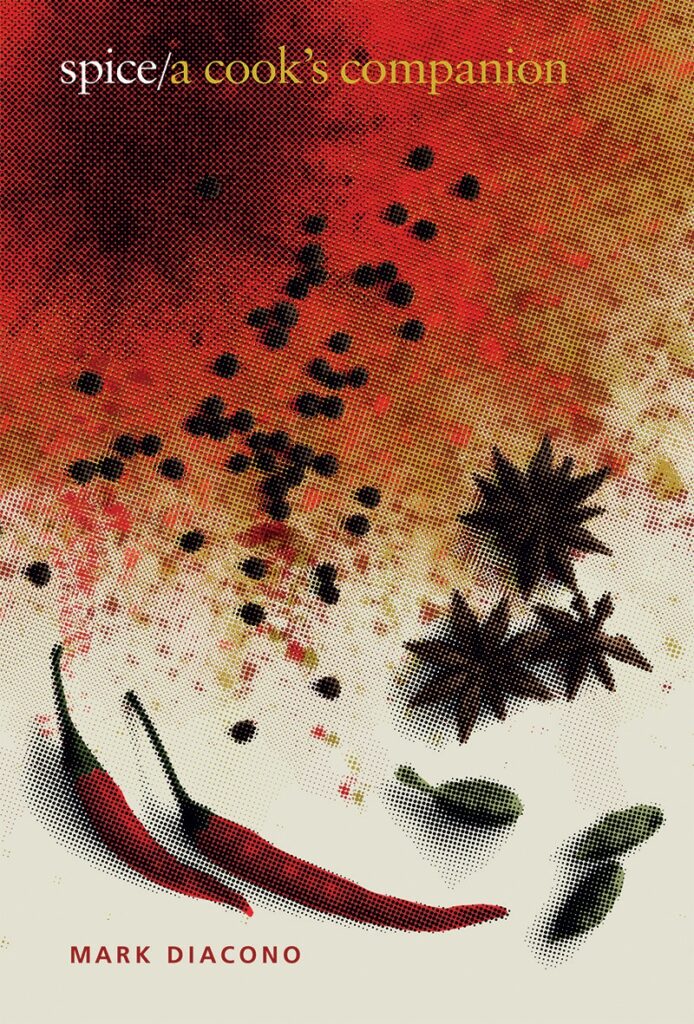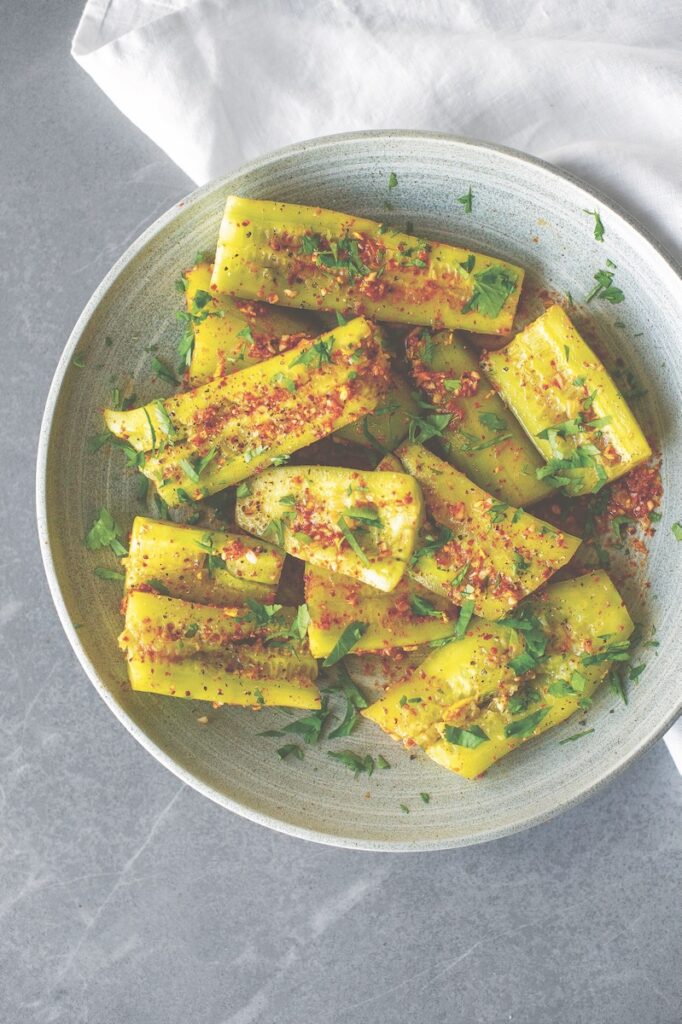Just the smell of spices wafting from the kitchen – sometimes homey and sometimes exotic – warms the appetite and ignites the imagination. James Beard-nominated Mark Diacono, author of 14 books on cooking and other kitchen matters, offers sage advice (pardon the pun) on spices, and encourages us to go forth boldly to try some new flavors.

Knowing Spices Can Completely Change Your Kitchen Game
I remember when my mother can home from the supermarket with a jar of mixed spice and dusted her apple filling with this mysterious powder. Despite eating as much of the Sunday roast as I could, the spicy scent coming from the oven had me hungrier than when I came to the table. This is the power of well deployed spices: their scent makes your nose a promise that their flavors deliver on.
If your use of spices is limited by long-held habit or by lack of exposure, it is easy to feel intimidated. Where do you start your journey, and with what?
Where to Start with Spices
The first rule of thumb is ‘easy does it.’ A heavy hand with something punchy like cloves can overpower your Christmas baking and put you off for life. That said, embrace the adventure without fear but with attention. Where a recipe allows, taste repeatedly as you go, adding more spice, incrementally, if you think it would improve the whole. Make notes for next time; scribble in the margin if you are following a written recipe. You will build up understanding and confidence surprisingly quickly.
The Four Most Important Things About Spices
- Buy good quality spices. Even something as familiar as black pepper can be a revelation when well-sourced. It adds a pungent, even fruity earthiness to a dish and can be at home with sweet as well as savory recipes. Look for someone who specializes; they are likely to be online.
- Buy whole spices where you can, in small quantities to enjoy them at their best, and keep them in jars out of direct sunlight.
- Invest in an electric grinder to grind spices as you need them for maximum flavor and scent. If you have a coffee grinder it almost certainly will do the job. As much as I love a pestle and mortar, the quick zip of a grinder’s motor has much to recommend it. Grind your spices just before you use them and be amazed at their liveliness and complexity: you are unlikely to go back to store-bought and ready-ground.
- Keep a nice, well-sourced clutch of spices in the pantry. Cardamom, cinnamon and vanilla resonate beautifully in baking. For meats, cumin, mustard, and chilli. For soups and stews, pepper and coriander. Because they’re ready and waiting, you’re more likely to spice things up with them.
Lesser Used Spices
Once you feel confident with widely available spices, keep feeding you inquisitiveness.
Black Limes
Aka Persian limes, these are created by brining and drying limes. They add flavorful sourness without increasing the liquid content as adding lemon juice does. Use them whole in curries and stews, or as a powder: try it sprinkled over sweet and savory dishes (it particularly suits fish, lentils and roasted vegetables).
Celery Seed
This spice has a soft, slightly bitter, celery flavor, along with gentler, grassy, earthy notes of parsley and mace. Wonderful in pickles and pakoras, celery seed makes a savory embellishment added to breads before baking. It is punchy, so go easy at first until you get to know it: stir 1 part celery seed into 2 parts salt and use where you would salt to get the measure of it.
Long Pepper
Along catkin-like pepper from Indonesia, with an extraordinary flavor of black pepper with hints of chocolate and cinnamon. Try it in tagines and pasta sauces, with lentils, or ground into a crumble topping.
Mace
From the same tree as we get nutmeg, mace shares much of nutmeg’s sweet, woody, citrus, clove, and mild peppery flavor and scent, with mace being softer and less resinous than nutmeg. It loves being infused in all kinds of dairy.
How to Use Spices
Add in Late
Many ground spices and blends are best not cooked or barely cooked. Garam masala is almost always at its best like this. If you are using an unfamiliar spice or blend, sprinkling a little on part of the dish is a great way of getting to know its qualities and getting a handle on how much you like.
Cooking
Some spices release their flavors over time, and/or need liquid to do so. For example, long, slow cooking of cinnamon stick in curries and allspice in stews brings a greater complexity of flavor.
Marinades
A paste that is applied before cooking, with the intention of imparting deeper flavoring over time.
Rubs
A dry form of marinade, or can be applied just before cooking.
Tempering
Typically, where spices are lightly fried in oil or ghee or dry toasted in a pan, to be used at the start of cooking, or added before serving.
Infusions
Where you take a spice’s flavor and aroma (without eating it) by infusing in a liquid.
Once you become confident in using spices, and inquisitive about trying the different flavors, familiar recipes take on a new life: now, every time I cook, I think ‘would this be improved by a spice or two?’, and the answer is almost always yes.
Where to Buy Spices
Supermarkets today carry a wide range of spices but for something truly tantalizing, try these online spice retailers. The quality is outstanding and you can usually buy in small amounts so you can try something new (urfu pepper, anyone?) and you’ll use them faster so they stay fresher.
La Boîte
The brainchild of Chef Lior Lev Sercarz, La Boite sources spices directly from the farmer and producer. Make sure and check out their specialty blends like Shabazi – a heady blend of cilantro, chili, garlic and lemon or smoked cinnamon – an oak-smoked cassia cinnamon that’s just the thing for your next batch of baking.
Kalustyan’s
Next time you’re in New York City, pay a pilgrimage to Kalustyan’s, an Aladdin’s cave of spices. Whole walls of chile, rows of cinnamon, as well as a secret stash of tinctures and tisanes await your perusal. Not in the big apple? You can experience it all at their online store.
Penzeys
We’ll admit we have a soft spot for Penzeys and their Pittsburgh bricks and mortar store. What’s not to love? They sell everything from adobo seasoning to za’atar, many available in trial bags so you can try something new – say, their Mural of Flavor with its blend of a dozen spices that’s so flavorful you can skip the salt.
Los Chileros
Fuel your inner chile fiend with an online visit to Los Chileros. Not only do they sell a huge range of dried whole chiles and powders but also other Southwestern goodies including their own line of rubs, mixes, salsas, and ground blue corn and posole.

Author Bio
James Beard-nominated Mark Diacono has written 14 books, as well as writing for newspapers and food and gardening magazines. His latest book is Vegetables: Easy and Inventive Vegetarian Suppers.
Interested in diving into spices? Try Mark’s recipe for Smashed Kimchi Cucumber.

Story by Mark Diacono
Styling by Anna Franklin
Featured Photography by Dave Bryce
Subscribe to TABLE Magazine‘s print edition.
